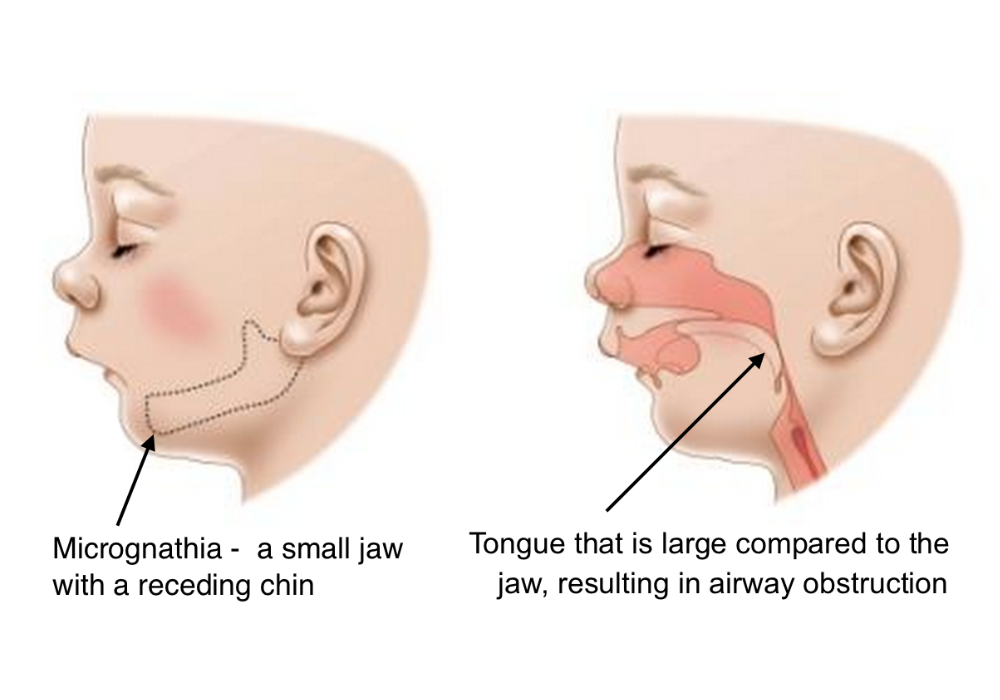Peirrie Robin Syndrome

What Is Peirrie Robin Syndrome?
While there has been ongoing debate about its definition, Pierre Robin syndrome, now more accurately termed Pierre Robin sequence, is characterized by micrognathia, glossoptosis, and airway obstruction. The initial description of Pierre Robin syndrome dates back to 1891 when Lannelongue and Menard reported two cases featuring micrognathia, cleft palate, and retroglossoptosis. In 1926, Pierre Robin himself published a case involving the complete syndrome. Until 1974, the triad was commonly referred to as Pierre Robin syndrome. However, the term “syndrome” is now specifically reserved for morphogenic errors with simultaneous multiple anomalies caused by a single etiology. The term “sequence” has been introduced to encompass conditions featuring a series of anomalies resulting from a cascade of events initiated by a single malformation.
In a 2009 article, Breugem and Courtemanche highlighted the confusion surrounding the classification of Robin sequence. They conducted a survey using questionnaires, addressing aspects such as the distinction between “retrognathia” and “micrognathia” and the potential influence of cleft type (e.g., “U-shaped” versus “V-shaped”) on decision-making processes. Additionally, a PubMed literature review of the 50 most recent articles on Robin sequence was included. The findings were perplexing, revealing 14 different definitions from the questionnaires and 15 distinct opinions regarding Robin sequence from the PubMed review of 50 publications.
Signs and symptoms of Pierre Robin sequence
These include the following:
-
Micrognathia – Reported in the majority of cases (91.7%)
-
Glossoptosis – Noted in 70-85% of reported cases
-
Macroglossia and ankyloglossia – Relatively rare findings, noted in 10-15% of reported cases
-
Otitis media – The most common otic anomaly, occurring 80% of the time
-
Auricular anomalies – 75% of cases
-
Hearing loss – Mostly conductive; occurs in 60% of patients
-
External auditory canal atresia – Occurs in only 5% of patients
-
Nasal deformities – Infrequent; consist mostly of anomalies of the nasal root
-
Dental and philtral malformations – Occur in one third of cases
-
Laryngomalacia – Occurs in approximately 10-15% of patients
-
Ocular anomalies – Reported in 10-30% of patients
-
Cardiovascular anomalies – Findings such as benign murmurs, pulmonary stenosis, patent ductus arteriosus, patent foramen ovale, atrial septal defect, and pulmonary hypertension have all been documented; their prevalence varies in the literature from 5-58%
-
Musculoskeletal anomalies – The most frequent systemic anomalies (noted in 70-80% of cases)
-
Central nervous system (CNS) defects – These include language delay, epilepsy, neurodevelopmental delay, hypotonia, and hydrocephalus; the incidence of CNS defects is around 50%
-
Genitourinary defects – May include undescended testes (25%), hydronephrosis (15%), and hydrocele (10%)
Associated syndromes and conditions include Stickler syndrome, trisomy 11q syndrome, trisomy 18 syndrome, velocardiofacial (Shprintzen) syndrome, deletion 4q syndrome, rheumatoid arthropathy, hypochondroplasia, Möbius syndrome, and CHARGE association.
Management of Pierre Robin sequence
Conservative management
In the majority of patients, conservative management with close observation and follow-up is successful. The natural history shows that with normal growth, airway compromise resolves without immediate surgical intervention. Isolated Pierre Robin syndrome (PRS) patients usually respond more favorably to the conservative approach.
Prone positional therapy has proved to be highly efficient in airway management. Oral airway placement, laryngeal mask, nasopharyngeal stenting, and short-term intubation (< 2 wk) are other options in case positioning is inadequate. Intubation is often difficult owing to micrognathia and should be performed by someone specialized in problematic pediatric airway management.
Feeding difficulties can be alleviated by upright feeding techniques, modification of the nipple for bottle feeding, temporary use of nasogastric or orogastric feeding tube, and the placement of a gastrostomy. Palatal plates such as the pre-epiglottic baton plate, which have a velar extension, pull the base of the tongue forward. This can be helpful in the relief of airway obstruction, and it also facilitates the swallowing mechanism during feeds.
Surgical management
Infants with pronounced micrognathia may experience severe respiratory distress or failure to thrive. Treatment is prioritized according to the severity of airway compromise followed by the extent of feeding difficulties. [3]
Although many different surgical procedures have been described, tracheostomy remains the most widely used technique. Other surgical procedures, such as subperiosteal release of the floor of the mouth, and different types of glossopexy, such as the Routledge procedure or other forms of tongue-lip adhesions, can be used. Mandibular lengthening by gradual distraction may be employed for severe mandibular hypoplasia that causes obstructive apnea.
Diagnosis is typically based on clinical features, including a small jaw, posteriorly placed tongue, and signs of airway obstruction. Imaging studies may be used to assess the severity of the condition.
The exact cause is not always clear, but it is believed to result from a combination of genetic and environmental factors. It may occur as an isolated condition or as part of a syndrome.
In some cases, ultrasound examinations during pregnancy may indicate the presence of Pierre Robin Sequence, but a definitive diagnosis often requires a postnatal evaluation.
Common complications include feeding difficulties, respiratory distress, and potential developmental issues. Airway management is a primary concern in infants with Pierre Robin Sequence.
Treatment approaches may include repositioning during sleep, specialized feeding techniques, and surgical interventions such as jaw distraction or cleft palate repair, depending on the severity of the condition.
Pierre Robin Sequence is considered relatively rare, and its prevalence is estimated to be around 1 in 8,500 to 1 in 30,000 live births.
Meet Our Surgeons
Opening Hours
Mon – Fri
08.00 -18.00
Sat – Sun
09.00 -15.00
Make Your Appointment

MDS, Oral & Maxillofacial Surgery Travel Fellowship (AOCMF, Germany)
Special Interest in: Oral Cancer, Orthognathic Surgery & Facial Deformity Correction

MDS, Oral & Maxillofacial Surgery Travel Fellowship, AOCMF(Beijing) Fellowship (AIMS, Kochi)
Special Interest In: Facial Reconstruction, Oral Cancer, Facial Trauma & Orthognathic Surgery

MDS, Oral & Maxillofacial Surgery
Special Interest In: Facial Reconstruction, Oral Cancer, Facial Trauma & Orthognathic Surgery
